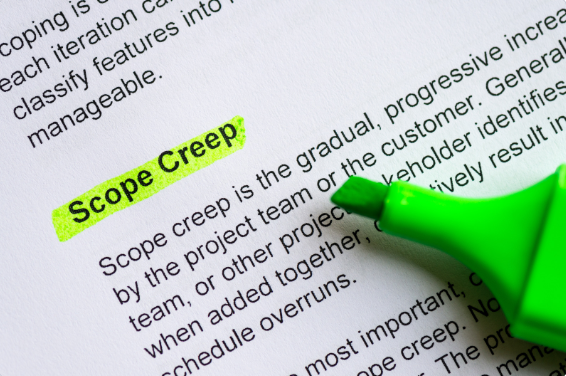
Failure to establish appropriate project management protocols, effective communication, or a thorough understanding of a project’s expectations can result in scope creep. Scope creep occurs when the project’s scope or specifications continuously expand beyond the initial objectives. This can result in incomplete projects, a disorganized work master schedule, and the wastage of valuable resources, making it crucial to prevent scope creep whenever feasible.
In project management, preventing scope creep is crucial to ensure the successful completion of a project within the defined parameters. By utilizing effective strategies and tools, project teams can minimize the risk of scope creep and maintain focus on project objectives. Collaborating on what the team is making, implementing project management tools, optimizing time on things workflow processes, and fostering clear communication are essential elements to prevent scope creep in project management. This article explores five key ways to prevent scope creep and enhance project success.
The following are 5 ways to prevent scope creep in project management:
Start with Ways to Simplify Project Scope Statement to Avoid Scope Creep

The project scope statement serves as a comprehensive document that outlines all the essential information required to complete a project, encompassing goals, objectives, and the specific deliverables necessary to achieve them. This document plays a crucial role in providing clarity and direction, ensuring that all team members understand what tasks need to be accomplished, by whom, and by when. The project scope statement must be reviewed and approved by all stakeholders responsible for its completion, as well as the project owner, to establish a shared understanding of project expectations. By incorporating the project scope statement into the project management process, teams can effectively track progress, manage tasks efficiently, and maintain focus on key aspects of the project. This approach to project management helps mitigate confusion and scope creep and facilitates a structured and organized approach to project execution. Leveraging a task management system and the best project tracking tools can further enhance project performance, ensuring all team members are aligned and working towards a common goal. Adhering to the project scope statement and utilizing the right tools and technology sets the stage for successful project delivery and establishes a solid foundation for future projects, promoting collaboration and accountability among team members.
Starting with a project scope statement is a fundamental step towards simplifying project management and ensuring the successful completion of tasks within a construction project. By clearly defining the project’s objectives, deliverables, and constraints, project managers can streamline task management and enhance the overall efficiency of project management tasks. This foundational document serves as a roadmap for the project, guiding team members toward the best project outcomes and monitoring project progress effectively. Embracing the discipline of creating a comprehensive project scope statement is one of the most effective ways to simplify project management processes and drive success in construction projects.
Simplify Complex Project Management

When tackling complex projects, it is essential to implement strategies to simplify project management and ensure high performance. One of the key tips to simplify a complex project is to define the aspects of project clearly from the outset. The project manager can create a roadmap that guides the team toward success. It is crucial to break down the project into manageable tasks and establish a clear project scope to avoid scope creep and maintain focus. Moreover, to tackle unprecedented changes and ensure high performance as well as monitoring individual performance and progress is vital. In many cases, project failures can be attributed to a lack of clarity and direction, making it easy to miss crucial details. By following these tips and implementing effective project management practices, high-performing projects can be achieved, ensuring that time and resources are spent on the right things to drive success.
Stick to the Project Management Features

Sticking to the project plan is essential for simplifying project management and ensuring successful project completion. By following the project plan diligently and utilizing strategies to simplify project work, project managers can streamline project tracking and optimize project progress. Embracing agile methodologies and incorporating the right project management tools can provide valuable insights and enhance project efficiency. To simplify your project and achieve desired outcomes, it is crucial to stay true to the project plan, prioritize tasks effectively, and adapt to changes promptly. Implementing these tips simplifies project management, checks in with teams , boost productivity, and achieve project success.
Adhering to the robust project management features is essential for effectively managing complex projects and reducing the risk of errors or delays. By utilizing a centralized location to access project-related information, team members can streamline communication, track progress, and collaborate more efficiently. Project managers must check in regularly regarding accountability within the team to ensure that the project is on track and that everyone is aligned with project objectives. Sticking to the project management features allows teams to focus their time on critical tasks and ensures that progress is being made toward project milestones. By maintaining consistency and utilizing the features provided by the project management tools, teams can mitigate risks, enhance productivity, and drive successful project outcomes.
Streamline and Simplify Communication Processes to Avoid Potential Risks
Effective communication is key to streamlining and simplifying project management processes, ensuring that project teams are aligned and focused on achieving project goals. By assigning tasks clearly and seamlessly communicating updates and progress, project managers can effectively manage projects and track performance. Establishing a structured communication plan and utilizing collaborative tools can enhance transparency and ensure that every project member is aware of how the project is moving forward. Simplifying communication processes not only improves project efficiency but also fosters a culture of accountability and teamwork. By prioritizing clear and efficient communication, project teams can boost project performance and drive successful project outcomes that can benefit teams and stakeholders.
In the dynamic field of marketing, taking a different approach can significantly impact the performance of a project and set it apart from competitors. By encouraging the team to explore innovative strategies and think outside the box, new perspectives can be gained that may lead to breakthroughs in various aspects of the project. It is essential for the team to stay on top of industry trends and consumer behavior, adapting their approach at every stage of the project to ensure relevance and effectiveness. Embracing a different approach not only challenges the team to be creative and flexible but also enhances overall project performance by keeping it aligned with the evolving landscape of the marketing field.
Learn How to Prioritize Objectives and Tasks Related Posts

Prioritizing objectives and tasks is essential for efficient task management and successful project delivery. By defining the project’s goals and objectives, project managers can establish a clear roadmap for the entire project and ensure that all team members are aligned throughout the project lifecycle. Utilizing the best project-tracking tools can help in monitoring progress and identifying critical tasks that need immediate attention. Effective prioritization not only helps in managing workload efficiently but also ensures timely project delivery. By prioritizing objectives and tasks within the team, project managers can address the most crucial aspects of the project first, leading to improved project outcomes and overall success.
Understanding what is required in each task can keep you on track and prevent you from adding in more unnecessary work. Not only that, but the visuals it provides helps you stay focused and clear on what direction to go. Often, scope creep is due to unclear goals or not understanding precisely what it takes to accomplish them.
Use Tools and Technology to Assist and Simplify Project Management

Integrating tools and technology into project management practices is crucial for ensuring that projects are completed on time and enhancing overall performance. By adopting an agile approach and utilizing advanced software, project managers can streamline processes, automate repetitive tasks, and ensure that the project stays on track. This enables teams to focus their time on more impactful activities, improving efficiency and productivity. Leveraging tools and technology not only benefits the current project but also sets a foundation for future endeavors. By embracing technology that offers features such as task automation and real-time collaboration, project teams are going to benefit from increased efficiency, reduced errors, and improved project outcomes. Implementing tools and technology into project management strategies empowers teams to work more effectively, stay organized, and achieve success in delivering projects on time and optimizing performance.
Don’t let scope creep take over your project and prevent success. Use these tools to be sure you prevent scope creep from taking over your project. It may seem beneficial to keep adding to a project, but ultimately it will allow you to lose sight of the original goal. Leaving your customers, your team, and even you disappointed.
In conclusion, utilizing tools and technology to assist in project management can significantly enhance the efficiency and effectiveness of tracking tasks and managing projects. By leveraging features like task tracking and project management software, project managers can streamline processes and ensure that tasks and projects are completed successfully. Incorporating user-friendly tools can simplify complex project management tasks, allowing teams to collaborate seamlessly and stay organized throughout the project. Embracing technology not only benefits the current project but also sets a strong foundation for future projects. By adopting tools and technology with advanced features, project managers can improve productivity, reduce errors, and enhance overall project performance, setting the stage for success in all endeavors.
